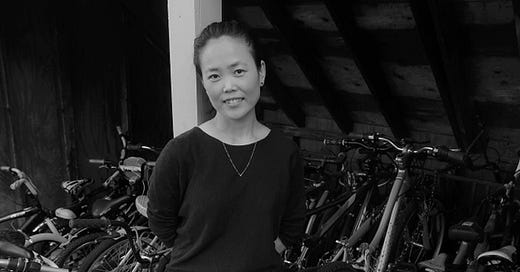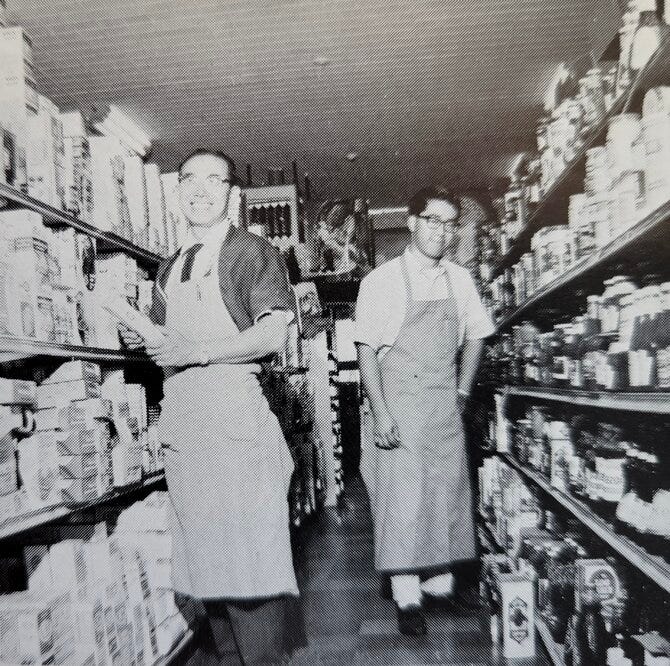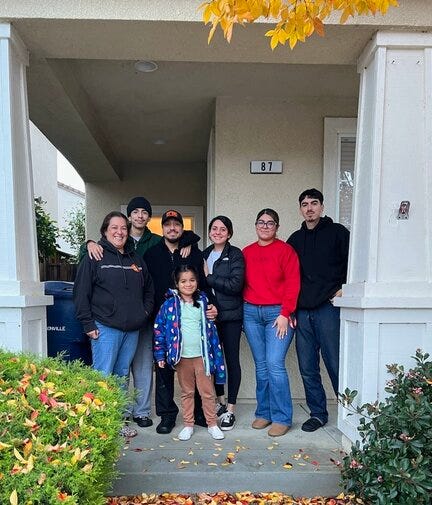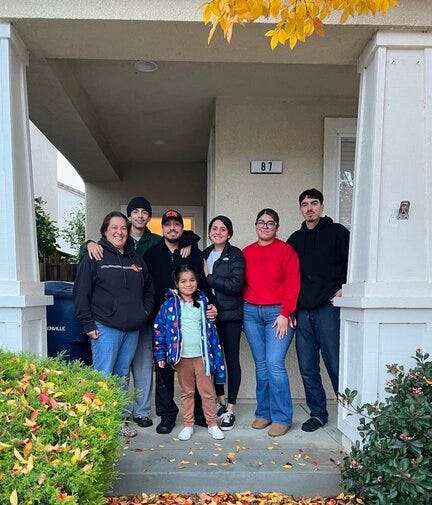More Stories of the American Dream
The Yamamotos of Santa Paula, Charlene of North Korea, and A Man and his House
Greetings all, and welcome. Some of you may notice that the title of this week’s post echoes the title of last week’s. The subject matter is similar, too. The reason is, Three Stories of America received such a strong and uplifting response from people that it deserved a kind of sequel.
This one is a little different from the first. It includes a piece by me at the end but even better, it features contributions from three of our readers, all of whom are friends of mine and happen to be supporting subscribers as well. Also, in a demonstration of Tilting West’s wide geographical reach, they live in Oakland, California, Spokane, Washington, and Woods Hole, Massachusetts, respectively. Let’s start it off with our Cali correspondent.
Fresh Orange Slices and More
Last week’s story about East Hills Market and the Jang family and their Chinese heritage resonated with frequent Tilting West contributor, Dan Crouch. A long-time resident of Oakland and the Bay Area, Dan grew up in Santa Paula, California, a Ventura County city of 30,000 people not far from the Pacific Coast that is about an hour’s drive north of Los Angeles.
In the midst of rich agricultural lands, Santa Paula labels itself the “citrus capital of the world” due to its abundance of lemon, orange, and avocado groves. Fittingly, it would seem, it also had a terrific grocery store that served as a gathering place for the community when Dan was growing up in the 1960s. As he recalls,
“My hometown also had a local grocery store where the locals would exchange greetings, news and gossip. Its official name was Garden Market, but everyone called it Mitch's Market because its owner, Mitch Yamamoto, was famous in Santa Paula for his community involvement and generosity. He was a huge booster of the town's sports teams and always provided fresh sliced oranges to athletes during halftimes of the high school football and basketball games.
“His family had been forced into relocation camps during World War II, but he returned to his hometown afterwards and reestablished himself as an ardent supporter of the community while also being quite open about his experiences during the war. A lot of Santa Paulans remember Mitch and his family—truly remarkable people.”
A football player at Santa Paula High, Dan was one of the athletes who at halftime enjoyed those invigorating orange slices that the Yamamotos served up.
Asked if he had any photos of them, Dan dug into his old high school yearbooks and found one: “As a matter of fact...I checked my high school yearbooks because there were local business sponsors who donated toward the production of the books, and the Garden Market was one of them. The photo is from the 1968 Santa Paula Union High School yearbook, El Solano. It shows Mitch Yamamoto and his son Dean at work in the market. Really nice family...”
The Jang family story also rekindled memories for another former southern Californian, Leyna Bernstein, who now lives in Spokane, Washington but who grew up in the Orange County town of Laguna Beach. Said Leyna:
“I truly enjoyed all three short pieces in this week’s edition. I always resonate with your stories about the Hayward in which you grew up, because I also grew up in a small town. The story about East Hills Market brought back memories of the local market and butcher shop where my mom always bought our meat. Thanks, Kevin!”
Charlene’s Story
One of the three stories of America we told last week was about Luisa, a Cuban-born mother and grandmother who had just passed her citizenship exam and was looking forward to the naturalization ceremony that would grant her full rights as a citizen.
Mark Chester has never met Luisa, but as he said to me in a note, “I can appreciate her joy.” Mark is a professional photographer and Massachusetts native who lives in the tiny Cape Cod port town of Woods Hole which, among its many attributes, is a ferry ride away from Martha’s Vineyard.
The picture of Charlene that graces the top of this post is Mark’s, and how he came to meet her, and photograph her, is a story worth telling. In many ways the story begins in the late 1970s when he was on assignment to shoot photographs for a book by Charles Kuralt, the famous CBS TV and radio news correspondent. One of Kuralt’s essays in Dateline America told about Ellis Island, and while walking through the historic gateway for American immigration Chester had what he calls an “epiphany.”
“It dawned on me,” he recalls, “that my father, his parents and siblings were born in Minsk, then a part of Russia, now Belarus. Growing up with them, I didn’t understand their speaking Yiddish. Nor did I understand when they spoke English with a Russian accent.”
This awareness of his own heritage and its impact on his life percolated for decades until, in 2011, he embarked on an extraordinary, self-appointed mission to photograph foreign-born residents of Massachusetts who had become U.S. naturalized citizens, much like his father. His files now contain the photos of more than 400 men, women and families born in 190 different countries. His book, The Bay State: A Multicultural Landscape: Photographs of New Americans,” features many of these images.
One of Mark’s goals was to include as many different countries as he could. His pictures feature people from every nation in Africa but one, for example. But his hardest “get,” the elusive Tantalus-like prize just out of his reach, was finding a representative from one of the most totalitarian regimes on earth, North Korea.
That’s when Charlene entered the frame.
It was at a naturalization ceremony in Hynes Auditorium in Boston. More than 2,700 people were in attendance. Scanning a long list of the attendees, Mark saw something he thought he’d never see: a name from North Korea.
“An individual born in North Korea was becoming a U.S. citizen here in Massachusetts. I knew it would be a challenge, but I felt optimistic. I felt it was meant to be that I would meet such a person.”
And it was, but only after a Taiwanese man came to the rescue. After googling “North Korea” to see how it was spelled, they borrowed a felt pen from an official at the ceremony and the man wrote a piece of calligraphy, in Korean script, on a sheet of paper.
Holding up this little sign, Mark stood on chairs in the back of the huge hall hoping to catch the eye of someone who could read what it said. Two Asian women were talking excitedly nearby. He approached them with a smile. “Their reaction said it all,” remembers Mark. “One smiled back, nodding ‘Yes.’”
Yes! It was indeed meant to be. Charlene even let Mark snap a picture of part of her precious naturalization certificate.
Note: Mark has released a new book of photographs, Roadshow Anthropology, which we’ll discuss in a future issue.
A Man, A House, and A Family
This is another American “meant to be” story. Although as Mark and all of us will surely testify, it can take a lot of struggle before a thing that is meant to be, actually comes to pass.
So it is with this story. It centers on a man, a house, and a number of families but one special one in particular.
The man’s name is Bruno. Born in Croatia, a survivor of the Holocaust, he came to this country during World War II under extremely hard and challenging circumstances. A former engineer who was a father and grandfather, he died last October a month short of his 95th birthday.
The house he lived in before his passing of lung and heart complications was in a pleasant little neighborhood in Watsonville, California. Watsonville is a long-time farming community probably not unlike Santa Paula. It’s a stone’s throw away from Monterey Bay not far from the beach city of Santa Cruz.
Bruno always bragged about the weather in his adopted town, and its cooling ocean breezes in the morning followed by the warm sunshine in the afternoon are indeed pleasant. A slough with walking and bicycling paths is nearby.
When he first moved there, twenty years ago, a field of strawberries sprouted on the other side of the fence across the street from him. Now the strawberries are gone, replaced by a FedEx distribution center where trucks come and go during the day. Thanks to Bruno’s efforts as president of the board of his neighborhood association, the trucks must quiet their business by evening.
There are basketball hoops in the driveways of people’s homes and kids ride bicycles and kick balls around on the street. His next door neighbor is friendly and helpful and she and Bruno became friends. For an old person of declining health it is good to have someone reliable close at hand to keep an eye on things, make sure he’s okay.
One time his neighbor had not seen or heard from him in a while and with the front door locked, she stepped around to the backyard to investigate if anything was wrong. That same morning Bruno ventured downstairs to the kitchen to fix himself a cup of coffee. He happened not to be wearing any clothes.
This was not the sight his neighbor expected to see, although it did provide great merriment to Bruno’s three daughters and his longtime female companion when they heard the story.
His companion lived in San Jose. So did one of his daughters. The other two lived in cities that were hours away by car. The distance between them and their father proved to be only one of the challenges they had to overcome as his condition faltered and his driving and independence came to an end.
The ragged and exhausting end game of life never proceeds in a straight line. It’s up and down and all over the place. Repeated doctor visits. Sudden trips to urgent care. In and out of hospitals. Endless calls and texts among family and helpers trying to figure out what to do next, whatever that next thing is, and there’s always something else.
One of Bruno’s most ardent desires was to stay in his house. The prospect of entering an institutional facility of any sort filled him with dread. His daughters and the others who cared about him agreed that it would never be a good fit for him, and they hired a round the clock in-home care team to tend to his needs.
While this solved one problem, another one rose in its place. End of life care, whether it be at home or in a facility, can be astronomically expensive. Resources were available but would they be enough? There were worries the house would have to be sold to cover the substantial sums that were required now and possibly in the future.
Fortunately that never happened. Bruno got his wish.
He died. In bed. At home.
After his long life came to an end his family decided jointly to delay the spreading of his ashes until this year, after things had settled down for them all. Meanwhile the other burdensome practical matters of death could not wait. They had to be attended to. One of them was, of course, the house.
They came together with a real estate agent. She was the perfect fit because she had experience with the government program that Bruno had qualified for when he bought the house. She could lead them through the sticky thicket of rules and procedures.
Something else happened that was perhaps even more providential: Eager, qualified buyers stepped up. They were a Mexican-American family, long-time Watsonville people. The mother worked in a nursing care facility. The father was a groundskeeper who worked part-time nights at the California Grill, which was Bruno’s favorite restaurant in town.
They had worked and saved and saved and worked and worked and saved and they had built up enough scratch to come up with a sizable down payment. They made a walk-through of the house even before the carpets were cleaned and they loved it.
What’s more, they had a daughter who was pregnant. The plan was for her to come live with them, at least temporarily, so that Grandma and Grandpa could help with the baby. They would have three generations living under the same roof.
Everyone got it—his daughters, the companion, the friendly neighbor, the agent. Bruno’s old house—where his grandsons and family had come to stay with him, where an elementary school was close by, where strawberry fields had once grown—this old house should go to this new family.
Make this deal happen. Get it done. And do it fast because Christmas was coming. Get them into this house in time to celebrate the birth of one child while looking ahead to the coming of another in the future.
And that’s what happened. It was meant to be. The real estate agent took this picture of family and friends on the steps of their new home:
For more about Bruno’s story, see The Gift of the Accordion.
Debby Morey on Accordion June 22
Brilliant and touching article about your father in law and the accordion. May he rest in peace. Libby has our grandfathers violin from Sweden. He didn’t go through the Holocaust, but other hardships to get here.
Debby
My response:
Thank you so much. Your grandfather's violin sounds like a fascinating story as well. People hang on to musical instruments in a way they don't always with other things because they are so special to them. Best, K










What a wonderful book project Mark Chester undertook. Thanks for sharing his story. I’m also happy to hear about the family who bought Bruno’s home!